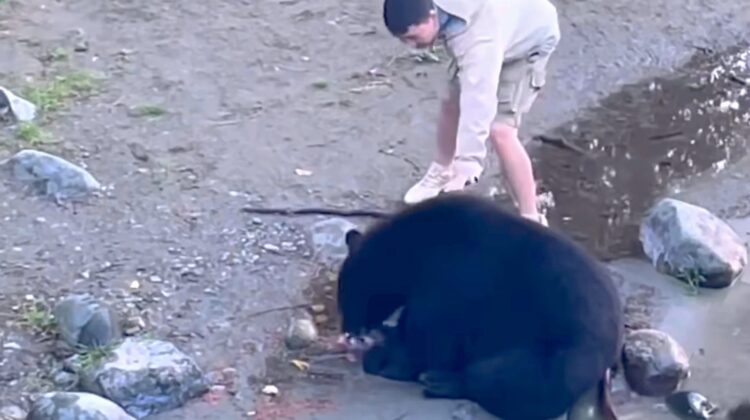
In the picturesque wilderness of Campbell River, British Columbia, Canada, a group of tourists recently received an unforgettable lesson on the dangers of “poking the bear.” The incident, captured on camera and shared via the Instagram account TouronsOfNationalParks, serves as a stark reminder of the need for wildlife respect and the potential consequences of approaching wild animals, especially when they are in the midst of a meal.
The video showcases a scene that unfolds like a wildlife thriller, with camera-wielding tourists seemingly oblivious to the risks of getting too close to a bear, particularly when it’s engaged in the essential act of eating. The tourists, driven by the desire for the perfect photo or a daring selfie, gradually encroach upon the bear’s space, disregarding the potential danger they are putting themselves in.

One particularly audacious tourist takes it a step further and actually reaches out to stroke the bear. The act of physically touching a wild bear is not only foolhardy but also incredibly risky, given the territorial and aggressive nature of bears, especially when it comes to their food. The shared video comes with a stern warning: “You should never get that close to a bear… EVER! Especially when the bear is eating a meal!”
The post on TouronsOfNationalParks emphasizes the importance of understanding wildlife viewing etiquette and exercising common sense when encountering animals in their natural habitat. Bears, in particular, can be extremely territorial, and approaching them during mealtime may trigger defensive behavior, putting humans at risk of serious harm.
This incident is just one in a series of recent close encounters between tourists and wildlife. In other instances, individuals have risked their safety by engaging in precarious activities, such as taking young children close to raging waterfalls or even poking other large animals like moose. These incidents underscore the need for education on responsible wildlife interaction and the potential consequences of disregarding nature’s boundaries.
Reports suggest that bear encounters are on the rise, with habituation being a significant factor. Habituation occurs when wild animals become accustomed to human presence without experiencing negative consequences. While bears are naturally wary of humans, their intelligence, opportunism, and adaptability make them susceptible to habituation, especially in areas densely populated by humans.
It is crucial to understand that habituation does not equate to domestication or tameness. Instead, it signifies that the bear no longer perceives humans as a threat, potentially leading to bold behavior if individuals approach too closely. The line between admiration from a safe distance and risky interference is thin, and incidents like the one in Campbell River serve as a stark reminder that, in the wild, caution and respect are paramount. As the video urges, “Be smart, use common sense, and learn basic wildlife viewing etiquette” to ensure both human safety and the well-being of the magnificent creatures that share our planet.

Leave a Reply